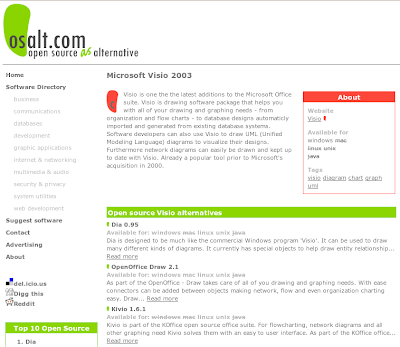Fedora beats Ubuntu: Dual-monitor configuration
I recently had the opportunity to help a co-worker setup Ubuntu 6.10 on his desktop. I was thrilled to see his surprise when he saw how nice the desktop looked. He told me that the Ubuntu desktop looks much better than the last time he had tried Linux.
My joy was short-lived when we started to look for a way to extend his desktop across a second monitor. I had never used dual-monitors before, but I assumed that Ubuntu would provide a tool since it does such a nice job in other areas. Unfortunately, there is no GUI tool to configure dual-monitor support in Ubuntu 6.10!
Here is how to manually configure dual-monitors in Ubuntu. Note: You are going to need this...

Meanwhile, Fedora Core has included a nice graphical tool to configure dual-monitor support. I don't know exactly when this feature was added, but it was in Fedora Core 4 which came out in June of 2005.

Let's learn from our friends at Fedora, and provide a GUI to configure dual-monitor setups. Ubuntu, are you going to include this in your next release? I sure hope so!
My joy was short-lived when we started to look for a way to extend his desktop across a second monitor. I had never used dual-monitors before, but I assumed that Ubuntu would provide a tool since it does such a nice job in other areas. Unfortunately, there is no GUI tool to configure dual-monitor support in Ubuntu 6.10!
Here is how to manually configure dual-monitors in Ubuntu. Note: You are going to need this...

Meanwhile, Fedora Core has included a nice graphical tool to configure dual-monitor support. I don't know exactly when this feature was added, but it was in Fedora Core 4 which came out in June of 2005.

Let's learn from our friends at Fedora, and provide a GUI to configure dual-monitor setups. Ubuntu, are you going to include this in your next release? I sure hope so!


Yeah that is one thing that I really like about Fedora. I wish Ubuntu had more GUI config tools for the display. Manually editing xorg.conf is a pain and often ends poorly.
ReplyDeleteLet's get it into Fiesty!
My desktop is now Knoppix (as Ubuntu and openSuse failed at hardware detection), as i needed Linux for Subversion. While before i had 3 screens without much trouble at all, now i'm only using the middle screen :-(
ReplyDeleteThis comment has been removed by the author.
ReplyDeleteI went through a similar hassle. But if you use KDE (kubuntu), you will find it immediately recognizes your screens.
ReplyDeleteThis may be useful if you dont want to switch OS, as you can add the KDE window manager to kubuntu.
First do an update:
# sudo aptitude update
Then install KDE (kubuntu desktop):
# sudo aptitude install kubuntu-desktop
Log out of ubuntu, and in the login (splash) screen select a different session type (KDE).
Itś better to use aptidude, as compared to apt-get or Synaptic because it does a better job of rempving it should you want to do so (sudo aptitude remove kubuntu-desktop)
Enjoy.
For a list of apps that work for me in ubuntu (or kubuntu) read http://marcelo-bbt.blogspot.com/
2007/02/favorite-apps-in-ubuntu.html
The reason that feisty and earlier don't have a configuration dialog is because x.org is getting the detection bits rewritten in the next release which is scheduled to be included in gutsy. Fedora has been around longer and therefore has had the need. Until feisty, there were a lot more pressing issues to fix and at the beginning of feisty's development it was decided not to develop or port a gui because it would have to be rewritten for Gutsy. They put the development effort into other areas. However I think that Gutsy and beyond will show massive improvement in this area due to the x.org 7.3 featureset. Check it out.
ReplyDeletePlease to see displayconfig:
ReplyDeletehttps://wiki.ubuntu.com/DisplayConfigGTK
https://blueprints.launchpad.net/ubuntu/+spec/displayconfig-gtk
https://launchpad.net/~displayconfig-gtk
https://launchpad.net/displayconfig-gtk
Based on the username and hostname in the terminal screenshot I'd assume you're using vmware to run your ubuntu machine (or reusing screen shots). How did you get vmware to emulate or pass dual monitors to the virtual machine?
ReplyDeleteJeffrey,
ReplyDeleteYou guessed it, those were both borrowed screenshots! However, I try to create my own screenshots for most of my posts.
As you may guess, I don't know anything about running dual-screens within a virtual machine.
Tristan